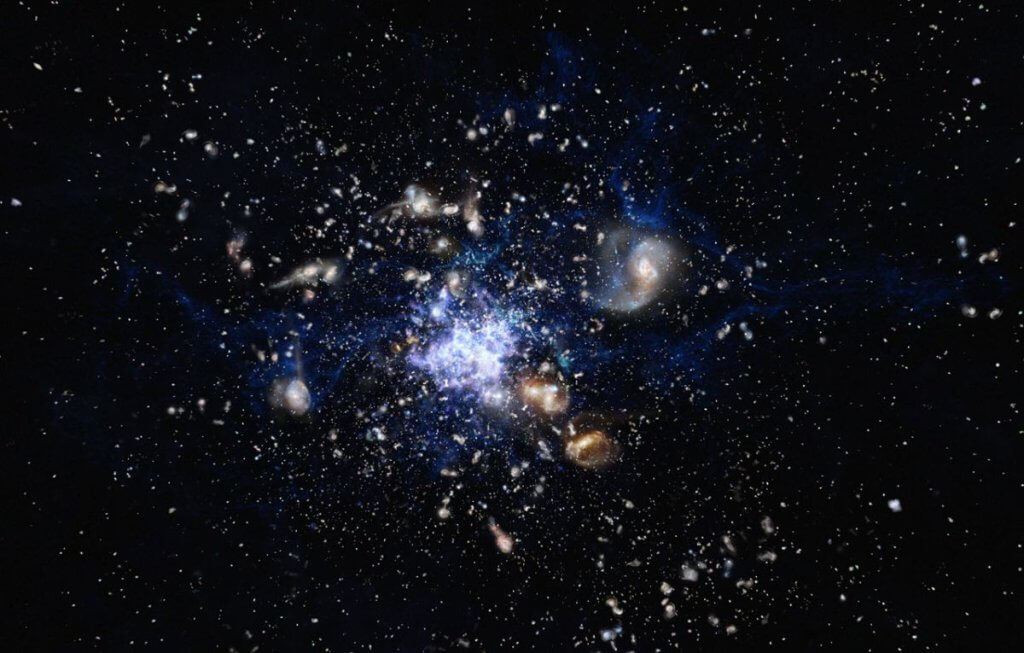
Giant proto-galaxy in early universe devours recycled material to birth new stars (Image Credit: Space.com)
Humans aren’t the only ones who recycle. Galaxies young and old do so too, by devouring used gas from their cosmic communities to evolve across eons.
In new research, astronomers have spotted a giant nebula in a thicket of young galaxies feeding on material some of them previously spewed out. The observations, which for the first time capture such a process just three billion years after the Big Bang, add to the growing evidence that galaxies mature by trading material with their local environments.
“We think that this is a common mechanism in galaxy formation,” Zheng Cai, a cosmologist at the Tsinghua University in China and a lead author of the new study, told Space.com. “With the help of the new observations, we are able to understand more [about] how massive galaxies accrete the gas and form stars.”
Related: What is the Big Bang theory?
Although galaxies, no matter their size, were once believed to be like lonely islands (opens in new tab) floating in a void, research has shown that they are surrounded by enormous yet ghostly clouds of gas and dust. These are thought to be part of a giant cosmic web, also containing elusive dark matter, that connects galaxies across space, providing pristine hydrogen as fuel for galaxies and stars to form.
More recently, astronomers have found such clouds also play a key role in recycling galaxy material by helping run so-called galactic fountains. For example, massive stars that die in violent supernova explosions blast out huge amounts of heavy metals, some of which may get pushed outside galaxies and form halos of hot gas above and below their disks.
One theory suggests that the ejected hot gas, which reaches a few thousand light-years beyond galaxy disks, cools and “rains” back into the galaxy, reigniting star formation. This theory addresses a long-standing puzzle of how galaxies — despite not having sufficient material within them — keep birthing stars across eons. Although simulations predict galaxy recycling is a very common process, astronomers find that testing those predictions is difficult because direct observations of this cosmic rain are hard to make, thanks to a myriad of galaxy orientations.
“Direct assessment of gas flows on galactic scales is a major unknown observationally, yet critical to galaxy formation,” Xavier Prochaska, professor of astronomy and astrophysics at the University of California, Santa Cruz and one of the authors of the latest study, told Space.com.
From ground-based observations using the Keck and Subaru telescopes in Hawaii, the study team imaged MAMMOTH-1, a bright nebula in a dense galaxy cluster roughly 11 billion light-years from Earth. MAMMOTH-1 was quite mysterious when the team discovered it back in 2017, but latest images show it feeding on material from its local environment via at least three streams of gas. These streams illuminate part of the cosmic web that connects galaxies with their local environments. Two streams point to a quasar — a bright celestial object powered by a supermassive black hole — whose existence in MAMMOTH-1 was only suspected so far.
The study team found the streams around the nebula to be rich in carbon, which is formed inside stars when lighter molecules like helium and hydrogen fuse to form “metals” (astronomers’ term for any element heavier than helium and hydrogen). So carbon’s presence in MAMMOTH-1, extending across 300,000 light-years, offers evidence of an active galactic recycling system in place, as the metal-rich gas will help trigger the birth of a new generation of stars in the growing nebula, researchers say.
“This metal-enriched gas, compared to pristine gas, can cool faster, which could make the star formation to be more efficient,” Cai told Space.com.
Because light takes time to travel across space, we are seeing the MAMMOTH-1 nebula as it was 11 billion years ago. The group of galaxies it belongs to then spanned 50 million light-years, but likely collapsed as it matured, such that today it may be densely packed across just one million light-years, astronomers say. In comparison, our local cosmic neighborhood — home to a group of galaxies including the Milky Way, all of which formed from similar clumps of gas and dust — spans 10 million light-years.
Our home galaxy, the Milky Way, also hosts galactic fountains, although astronomers don’t know exactly how many are sprouting from its disk.
“Our galaxy is, by and large, about as normal of a star-forming galaxy as it gets,” Prochaska said. “We can observe evidence of recycling even today.”
The new study (opens in new tab) was published Thursday (May 4) in the journal Science.
Follow Sharmila Kuthunur on Twitter @Sharmilakg (opens in new tab). Follow us on Twitter @Spacedotcom (opens in new tab) or Facebook (opens in new tab).





